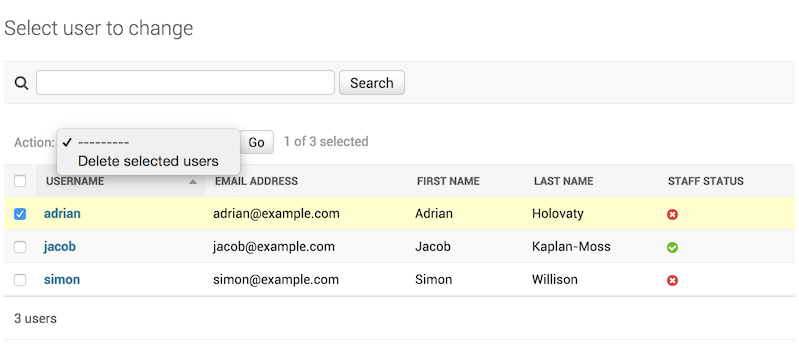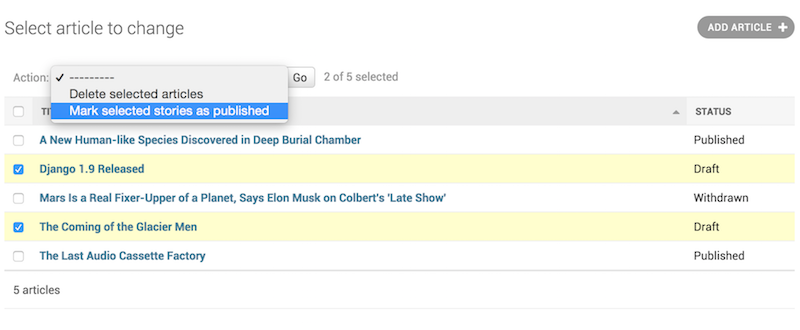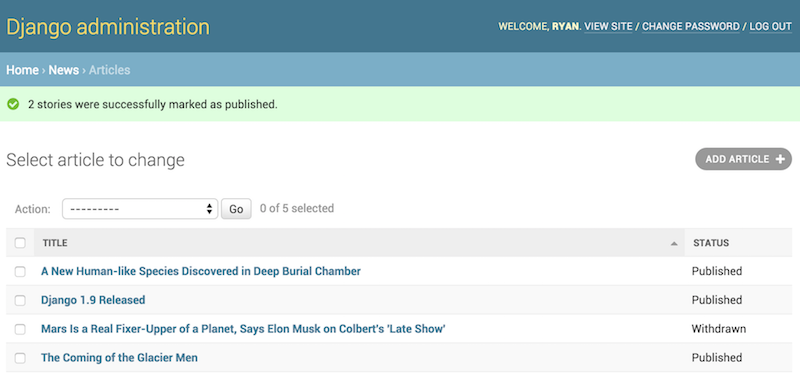Admin actions¶
The basic workflow of Django’s admin is, in a nutshell, “select an object, then change it.” This works well for a majority of use cases. However, if you need to make the same change to many objects at once, this workflow can be quite tedious.
In these cases, Django’s admin lets you write and register “actions” – simple functions that get called with a list of objects selected on the change list page.
If you look at any change list in the admin, you’ll see this feature in
action; Django ships with a “delete selected objects” action available to all
models. For example, here’s the user module from Django’s built-in
django.contrib.auth app:

Warning
The “delete selected objects” action uses QuerySet.delete() for efficiency reasons, which
has an important caveat: your model’s delete() method will not be
called.
If you wish to override this behavior, simply write a custom action which
accomplishes deletion in your preferred manner – for example, by calling
Model.delete() for each of the selected items.
For more background on bulk deletion, see the documentation on object deletion.
Read on to find out how to add your own actions to this list.
Writing actions¶
The easiest way to explain actions is by example, so let’s dive in.
A common use case for admin actions is the bulk updating of a model. Imagine a
simple news application with an Article model:
from django.db import models
STATUS_CHOICES = (
('d', 'Draft'),
('p', 'Published'),
('w', 'Withdrawn'),
)
class Article(models.Model):
title = models.CharField(max_length=100)
body = models.TextField()
status = models.CharField(max_length=1, choices=STATUS_CHOICES)
def __str__(self): # __unicode__ on Python 2
return self.title
A common task we might perform with a model like this is to update an article’s status from “draft” to “published”. We could easily do this in the admin one article at a time, but if we wanted to bulk-publish a group of articles, it’d be tedious. So, let’s write an action that lets us change an article’s status to “published.”
Writing action functions¶
First, we’ll need to write a function that gets called when the action is triggered from the admin. Action functions are just regular functions that take three arguments:
- The current
ModelAdmin - An
HttpRequestrepresenting the current request, - A
QuerySetcontaining the set of objects selected by the user.
Our publish-these-articles function won’t need the ModelAdmin or the
request object, but we will use the queryset:
def make_published(modeladmin, request, queryset):
queryset.update(status='p')
Note
For the best performance, we’re using the queryset’s update method. Other types of actions might need to deal with each object individually; in these cases we’d just iterate over the queryset:
for obj in queryset:
do_something_with(obj)
That’s actually all there is to writing an action! However, we’ll take one
more optional-but-useful step and give the action a “nice” title in the admin.
By default, this action would appear in the action list as “Make published” –
the function name, with underscores replaced by spaces. That’s fine, but we
can provide a better, more human-friendly name by giving the
make_published function a short_description attribute:
def make_published(modeladmin, request, queryset):
queryset.update(status='p')
make_published.short_description = "Mark selected stories as published"
Note
This might look familiar; the admin’s list_display option uses the
same technique to provide human-readable descriptions for callback
functions registered there, too.
Adding actions to the ModelAdmin¶
Next, we’ll need to inform our ModelAdmin of the action. This works
just like any other configuration option. So, the complete admin.py with
the action and its registration would look like:
from django.contrib import admin
from myapp.models import Article
def make_published(modeladmin, request, queryset):
queryset.update(status='p')
make_published.short_description = "Mark selected stories as published"
class ArticleAdmin(admin.ModelAdmin):
list_display = ['title', 'status']
ordering = ['title']
actions = [make_published]
admin.site.register(Article, ArticleAdmin)
That code will give us an admin change list that looks something like this:

That’s really all there is to it! If you’re itching to write your own actions, you now know enough to get started. The rest of this document just covers more advanced techniques.
Handling errors in actions¶
If there are foreseeable error conditions that may occur while running your
action, you should gracefully inform the user of the problem. This means
handling exceptions and using
django.contrib.admin.ModelAdmin.message_user() to display a user friendly
description of the problem in the response.
Advanced action techniques¶
There’s a couple of extra options and possibilities you can exploit for more advanced options.
Actions as ModelAdmin methods¶
The example above shows the make_published action defined as a simple
function. That’s perfectly fine, but it’s not perfect from a code design point
of view: since the action is tightly coupled to the Article object, it
makes sense to hook the action to the ArticleAdmin object itself.
That’s easy enough to do:
class ArticleAdmin(admin.ModelAdmin):
...
actions = ['make_published']
def make_published(self, request, queryset):
queryset.update(status='p')
make_published.short_description = "Mark selected stories as published"
Notice first that we’ve moved make_published into a method and renamed the
modeladmin parameter to self, and second that we’ve now put the string
'make_published' in actions instead of a direct function reference. This
tells the ModelAdmin to look up the action as a method.
Defining actions as methods gives the action more straightforward, idiomatic
access to the ModelAdmin itself, allowing the action to call any of the
methods provided by the admin.
For example, we can use self to flash a message to the user informing her
that the action was successful:
class ArticleAdmin(admin.ModelAdmin):
...
def make_published(self, request, queryset):
rows_updated = queryset.update(status='p')
if rows_updated == 1:
message_bit = "1 story was"
else:
message_bit = "%s stories were" % rows_updated
self.message_user(request, "%s successfully marked as published." % message_bit)
This make the action match what the admin itself does after successfully performing an action:

Actions that provide intermediate pages¶
By default, after an action is performed the user is simply redirected back to the original change list page. However, some actions, especially more complex ones, will need to return intermediate pages. For example, the built-in delete action asks for confirmation before deleting the selected objects.
To provide an intermediary page, simply return an
HttpResponse (or subclass) from your action. For
example, you might write a simple export function that uses Django’s
serialization functions to dump some selected
objects as JSON:
from django.http import HttpResponse
from django.core import serializers
def export_as_json(modeladmin, request, queryset):
response = HttpResponse(content_type="application/json")
serializers.serialize("json", queryset, stream=response)
return response
Generally, something like the above isn’t considered a great idea. Most of the
time, the best practice will be to return an
HttpResponseRedirect and redirect the user to a view
you’ve written, passing the list of selected objects in the GET query string.
This allows you to provide complex interaction logic on the intermediary
pages. For example, if you wanted to provide a more complete export function,
you’d want to let the user choose a format, and possibly a list of fields to
include in the export. The best thing to do would be to write a small action
that simply redirects to your custom export view:
from django.contrib import admin
from django.contrib.contenttypes.models import ContentType
from django.http import HttpResponseRedirect
def export_selected_objects(modeladmin, request, queryset):
selected = request.POST.getlist(admin.ACTION_CHECKBOX_NAME)
ct = ContentType.objects.get_for_model(queryset.model)
return HttpResponseRedirect("/export/?ct=%s&ids=%s" % (ct.pk, ",".join(selected)))
As you can see, the action is the simple part; all the complex logic would
belong in your export view. This would need to deal with objects of any type,
hence the business with the ContentType.
Writing this view is left as an exercise to the reader.
Making actions available site-wide¶
-
AdminSite.add_action(action, name=None)[source]¶ Some actions are best if they’re made available to any object in the admin site – the export action defined above would be a good candidate. You can make an action globally available using
AdminSite.add_action(). For example:from django.contrib import admin admin.site.add_action(export_selected_objects)
This makes the
export_selected_objectsaction globally available as an action named “export_selected_objects”. You can explicitly give the action a name – good if you later want to programmatically remove the action – by passing a second argument toAdminSite.add_action():admin.site.add_action(export_selected_objects, 'export_selected')
Disabling actions¶
Sometimes you need to disable certain actions – especially those registered site-wide – for particular objects. There’s a few ways you can disable actions:
Disabling a site-wide action¶
-
AdminSite.disable_action(name)[source]¶ If you need to disable a site-wide action you can call
AdminSite.disable_action().For example, you can use this method to remove the built-in “delete selected objects” action:
admin.site.disable_action('delete_selected')
Once you’ve done the above, that action will no longer be available site-wide.
If, however, you need to re-enable a globally-disabled action for one particular model, simply list it explicitly in your
ModelAdmin.actionslist:# Globally disable delete selected admin.site.disable_action('delete_selected') # This ModelAdmin will not have delete_selected available class SomeModelAdmin(admin.ModelAdmin): actions = ['some_other_action'] ... # This one will class AnotherModelAdmin(admin.ModelAdmin): actions = ['delete_selected', 'a_third_action'] ...
Disabling all actions for a particular ModelAdmin¶
If you want no bulk actions available for a given ModelAdmin, simply
set ModelAdmin.actions to None:
class MyModelAdmin(admin.ModelAdmin):
actions = None
This tells the ModelAdmin to not display or allow any actions,
including any site-wide actions.
Conditionally enabling or disabling actions¶
-
ModelAdmin.get_actions(request)[source]¶ Finally, you can conditionally enable or disable actions on a per-request (and hence per-user basis) by overriding
ModelAdmin.get_actions().This returns a dictionary of actions allowed. The keys are action names, and the values are
(function, name, short_description)tuples.Most of the time you’ll use this method to conditionally remove actions from the list gathered by the superclass. For example, if I only wanted users whose names begin with ‘J’ to be able to delete objects in bulk, I could do the following:
class MyModelAdmin(admin.ModelAdmin): ... def get_actions(self, request): actions = super(MyModelAdmin, self).get_actions(request) if request.user.username[0].upper() != 'J': if 'delete_selected' in actions: del actions['delete_selected'] return actions
Last update:
Jun 14, 2020